Improving the Mechanical Properties of Concrete Mixtures by Shape Memory Alloy Fibers and Silica Fume
Abstract
:1. Introduction
Research Objectives
2. Materials and Methods
2.1. Materials
2.2. Experimental Procedure
2.2.1. Mixture Proportioning
2.2.2. Testing of Specimens
3. Results and Discussion
3.1. Slump and Density Test Results
3.2. Primary and Secondary Compressive Strength Test Results
3.3. Splitting Tensile and Flexural Strength Test Results
3.4. UPV Test Results
3.5. Correlation Results
4. Conclusions
- Replacing SF with cement in the concrete structure by strengthening the cement paste makes the bonding between the aggregates stronger and improves the strength parameters. The highest of this improvement is related to SF10, which caused a 14% increment in compressive strength, 7% in splitting tensile strength, and 10% in flexural strength of the samples compared to OPC.
- The higher content of SMA indicates the most significant improvements in the mechanical properties of concrete mixtures, so that SMA0.3 has improved compressive strength by 2%, splitting tensile strength by 5.5%, and flexural strength by 8% in comparison with OPC.
- Another ability that SMA creates in concrete is due to the properties of reversibility and superelasticity of this material, which show well in the secondary compressive strength test. The decreased rate of secondary compressive strength compared to the primary in mixtures containing SMA after heating is much lower than in other samples. For example, in SMA0.3, the secondary compressive strength has decreased by only 16%, but in OPC, this value is equal to 28%.
- SF10SMA0.3 positively affects improving the mechanical characteristics of concrete mixtures. So that the compressive strength has an increment of 11%, the splitting tensile strength by 6.7%, and the flexural strength by 12.5% in comparison with OPC, it can be said that the concurrent application of these two modifiers in concrete structures has been successful.
- UPV in the mix design containing SF is higher than the fiber samples and even the control sample, so that SF10, just like the compressive strength test, has registered the highest UPV and MOE among all designs.
- The obtained R2 value indicates that the compressive strength of samples comprising SMA has a very high correlation with the secondary compressive, splitting tensile, and flexural strengths of mixtures containing these fibers. In addition, the compressive strength of the mix designs comprising SF has an acceptable correlation with the secondary compressive and splitting tensile strengths.
- For future research directions, the long-term influence of SMA and SF on concrete is recommended to be investigated. A wider array of mix designs incorporating both SF and SMA can also be explored to fully assess their synergistic effects on the mechanical properties of concrete. Moreover, various machine learning methods [84,85,86] can be developed to predict the behavior of SMA and SF-reinforced concrete.
Author Contributions
Funding
Data Availability Statement
Conflicts of Interest
References
- Han, S.; Zheng, D.; Mehdizadeh, B.; Nasr, E.A.; Khandaker, M.U.; Salman, M.; Mehrabi, P. Sustainable design of self-consolidating green concrete with partial replacements for cement through neural-network and fuzzy technique. Sustainability 2023, 15, 4752. [Google Scholar] [CrossRef]
- Liu, J.; Mohammadi, M.; Zhan, Y.; Zheng, P.; Rashidi, M.; Mehrabi, P. Utilizing artificial intelligence to predict the superplasticizer demand of self-consolidating concrete incorporating pumice, slag, and fly ash powders. Materials 2021, 14, 6792. [Google Scholar] [CrossRef]
- Tapas, M.; Song, Z.; Mortazavi, M.; Moghaddam, F.; Sirivivatnanon, V. Particle Packing Theory in Ultra-Sustainable Concrete with High SCM Content. 2021. Available online: https://opus.lib.uts.edu.au/bitstream/10453/162391/2/Particle%20Packing%20Theory%20in%20Ultra-sustainable%20Concrete%20with%20High%20SCM.pdf (accessed on 19 May 2024).
- Shabbir, F.; Bahrami, A.; Ahmad, I.; Shakouri Mahmoudabadi, N.; Iqbal, M.; Ahmad, A.; Özkılıç, Y.O. Experimental and Numerical Investigation of Construction Defects in Reinforced Concrete Corbels. Buildings 2023, 13, 2247. [Google Scholar] [CrossRef]
- Liu, B.; Yang, H.; Karekal, S. Effect of water content on argillization of mudstone during the tunnelling process. Rock Mech. Rock Eng. 2020, 53, 799–813. [Google Scholar] [CrossRef]
- Yang, H.; Song, K.; Zhou, J. Automated recognition model of geomechanical information based on operational data of tunneling boring machines. Rock Mech. Rock Eng. 2022, 55, 1499–1516. [Google Scholar] [CrossRef]
- Razi, S.; Wang, X.; Mehreganian, N.; Tootkaboni, M.; Louhghalam, A. Application of mean-force potential lattice element method to modeling complex structures. Int. J. Mech. Sci. 2023, 260, 108653. [Google Scholar] [CrossRef]
- Samadi, M.; Jahan, N. Determining the effective level of outrigger in preventing collapse of tall buildings by IDA with an alternative damage measure. Eng. Struct. 2019, 191, 104–116. [Google Scholar] [CrossRef]
- Vahid, R.; Farnood Ahmadi, F.; Mohammadi, N. Earthquake damage modeling using cellular automata and fuzzy rule-based models. Arab. J. Geosci. 2021, 14, 1274. [Google Scholar] [CrossRef]
- Samadi, M.; Jahan, N. Comparative study on the effect of outrigger on seismic response of tall buildings with braced and RC wall core. I: Optimum level and examining modal response spectrum analysis reliability. Struct. Des. Tall Spec. Build. 2021, 30, e1848. [Google Scholar] [CrossRef]
- Souri, O.; Mofid, M. Seismic evaluation of concentrically braced steel frames equipped with yielding elements and BRBs. Results Eng. 2023, 17, 100853. [Google Scholar] [CrossRef]
- Asgari, M.; Khodakarami, M.; Vahdani, R. The effect of topographic irregularities on seismic response of the concrete rectangular liquid storage tanks incorporating soil–structure–liquid interaction. Iran. J. Sci. Technol. Trans. Civ. Eng. 2020, 44, 1179–1197. [Google Scholar] [CrossRef]
- Jaradat, Y.; Far, H.; Mortazavi, M. A Mathematical Approach for Predicting Sufficient Separation Gap between Adjacent Buildings to Avoid Earthquake-Induced Pounding. Civ. Eng. J. 2023, 9, 2370–2398. [Google Scholar] [CrossRef]
- Hu, D.; Sun, H.; Mehrabi, P.; Ali, Y.A.; Al-Razgan, M. Application of artificial intelligence technique in optimization and prediction of the stability of the walls against wind loads in building design. Mech. Adv. Mater. Struct. 2023, 1–18. [Google Scholar] [CrossRef]
- He, H.; Qiao, H.; Sun, T.; Yang, H.; He, C. Research progress in mechanisms, influence factors and improvement routes of chloride binding for cement composites. J. Build. Eng. 2024, 86, 108978. [Google Scholar] [CrossRef]
- Adiguzel, D.; Tuylu, S.; Eker, H. Utilization of tailings in concrete products: A review. Constr. Build. Mater. 2022, 360, 129574. [Google Scholar] [CrossRef]
- Demir Şahin, D.; Eker, H. Effects of Ultrafine Fly Ash against Sulphate Reaction in Concrete Structures. Materials 2024, 17, 1442. [Google Scholar] [CrossRef]
- Esmaili, A.; Oshanreh, M.M.; Naderian, S.; MacKenzie, D.; Chen, C. Assessing the spatial distributions of public electric vehicle charging stations with emphasis on equity considerations in King County, Washington. Sustain. Cities Soc. 2024, 107, 105409. [Google Scholar] [CrossRef]
- Sousa, V.; Bogas, J.A.; Real, S.; Meireles, I. Industrial production of recycled cement: Energy consumption and carbon dioxide emission estimation. Environ. Sci. Pollut. Res. 2023, 30, 8778–8789. [Google Scholar] [CrossRef]
- Liu, Y.; Wang, B.; Fan, Y.; Yu, J.; Shi, T.; Zhou, Y.; Song, Y.; Xu, G.; Xiong, C.; Zhou, X. Effects of reactive MgO on durability and microstructure of cement-based materials: Considering carbonation and pH value. Constr. Build. Mater. 2024, 426, 136216. [Google Scholar] [CrossRef]
- El-Feky, M.; Kohail, M.; El-Tair, A.M.; Serag, M. Effect of microwave curing as compared with conventional regimes on the performance of alkali activated slag pastes. Constr. Build. Mater. 2020, 233, 117268. [Google Scholar] [CrossRef]
- Hamed, Y.R.; Elshikh, M.M.Y.; Elshami, A.A.; Matthana, M.H.; Youssf, O. Mechanical properties of fly ash and silica fume based geopolymer concrete made with magnetized water activator. Constr. Build. Mater. 2024, 411, 134376. [Google Scholar] [CrossRef]
- Singh, S.; Ransinchung, G.; Kumar, P. Effect of mineral admixtures on fresh, mechanical and durability properties of RAP inclusive concrete. Constr. Build. Mater. 2017, 156, 19–27. [Google Scholar] [CrossRef]
- Paul, D.K.; Gnanendran, C.T. Characterization of lightly stabilized granular base materials using monotonic and cyclic load flexural testing. J. Mater. Civ. Eng. 2016, 28, 04015074. [Google Scholar] [CrossRef]
- Mozafarjazi, M.; Rabiee, R. Experimental and numerical study on the load-bearing capacity, ductility and energy absorption of RC shear walls with opening containing zeolite and silica fume. Eng. Solid Mech. 2024, 12, 237–246. [Google Scholar] [CrossRef]
- Villar-Cociña, E.; Rodier, L.; Savastano, H.; Lefrán, M.; Rojas, M.F. A comparative study on the pozzolanic activity between bamboo leaves ash and silica fume: Kinetic parameters. Waste Biomass Valorization 2020, 11, 1627–1634. [Google Scholar] [CrossRef]
- Sharaky, I.; Megahed, F.; Seleem, M.; Badawy, A. The influence of silica fume, nano silica and mixing method on the strength and durability of concrete. SN Appl. Sci. 2019, 1, 575. [Google Scholar] [CrossRef]
- Ghasemi, A.; Naser, M.Z. Tailoring 3D printed concrete through explainable artificial intelligence. Structures 2023, 56, 104850. [Google Scholar] [CrossRef]
- Choudhary, R.; Gupta, R.; Alomayri, T.; Jain, A.; Nagar, R. Permeation, corrosion, and drying shrinkage assessment of self-compacting high strength concrete comprising waste marble slurry and fly ash, with silica fume. Structures 2021, 33, 971–985. [Google Scholar] [CrossRef]
- Eker, H.; Bascetin, A. Influence of silica fume on mechanical property of cemented paste backfill. Constr. Build. Mater. 2022, 317, 126089. [Google Scholar] [CrossRef]
- Bakhshi, A.; Sedghi, R.; Hojati, M. A Preliminary Study on the Mix Design of 3D-Printable Engineered Cementitious Composite. In Proceedings of the Tran-SET 2021, Online, 3–4 June 2021; pp. 199–211. [Google Scholar] [CrossRef]
- Pandey, A.; Kumar, B. Effects of rice straw ash and micro silica on mechanical properties of pavement quality concrete. J. Build. Eng. 2019, 26, 100889. [Google Scholar] [CrossRef]
- Luo, T.; Hua, C.; Liu, F.; Sun, Q.; Yi, Y.; Pan, X. Effect of adding solid waste silica fume as a cement paste replacement on the properties of fresh and hardened concrete. Case Stud. Constr. Mater. 2022, 16, e01048. [Google Scholar] [CrossRef]
- Wan, Z.; He, T.; Chang, N.; Yang, R.; Qiu, H. Effect of silica fume on shrinkage of cement-based materials mixed with alkali accelerator and alkali-free accelerator. J. Mater. Res. Technol. 2023, 22, 825–837. [Google Scholar] [CrossRef]
- Cui, D.; Wang, L.; Zhang, C.; Xue, H.; Gao, D.; Chen, F. Dynamic Splitting Performance and Energy Dissipation of Fiber-Reinforced Concrete under Impact Loading. Materials 2024, 17, 421. [Google Scholar] [CrossRef]
- Shakouri Mahmoudabadi, N.; Bahrami, A.; Saghir, S.; Ahmad, A.; Iqbal, M.; Elchalakani, M.; Özkılıç, Y.O. Effects of eccentric loading on performance of concrete columns reinforced with glass fiber-reinforced polymer bars. Sci. Rep. 2024, 14, 1890. [Google Scholar] [CrossRef]
- Zhou, Y.; Jiang, Z.; Zhu, X. Predictive Analysis of Concrete Slump Using a Stochastic Search-Consolidated Neural Network. Heliyon 2024, 10, e30677. [Google Scholar] [CrossRef]
- Shi, M.; Xu, G.; Zhao, J.; Xu, L. The study on bond-slip constitutive model of shape memory alloy fiber-reinforced concrete. Constr. Build. Mater. 2024, 418, 135395. [Google Scholar] [CrossRef]
- Abou-Elfath, H. Ductility characteristics of concrete frames reinforced with superelastic shape memory alloys. Alex. Eng. J. 2018, 57, 4121–4132. [Google Scholar] [CrossRef]
- Cladera, A.; Weber, B.; Leinenbach, C.; Czaderski, C.; Shahverdi, M.; Motavalli, M. Iron-based shape memory alloys for civil engineering structures: An overview. Constr. Build. Mater. 2014, 63, 281–293. [Google Scholar] [CrossRef]
- Aslani, F.; Liu, Y.; Wang, Y. Flexural and toughness properties of NiTi shape memory alloy, polypropylene and steel fibres in self-compacting concrete. J. Intell. Mater. Syst. Struct. 2020, 31, 3–16. [Google Scholar] [CrossRef]
- Wang, Y.; Aslani, F.; Valizadeh, A. An investigation into the mechanical behaviour of fibre-reinforced geopolymer concrete incorporating NiTi shape memory alloy, steel and polypropylene fibres. Constr. Build. Mater. 2020, 259, 119765. [Google Scholar] [CrossRef]
- Aslani, F.; Liu, Y.; Wang, Y. The effect of NiTi shape memory alloy, polypropylene and steel fibres on the fresh and mechanical properties of self-compacting concrete. Constr. Build. Mater. 2019, 215, 644–659. [Google Scholar] [CrossRef]
- Li, H.; Liu, Z.-Q.; Ou, J.-P. Experimental study of a simple reinforced concrete beam temporarily strengthened by SMA wires followed by permanent strengthening with CFRP plates. Eng. Struct. 2008, 30, 716–723. [Google Scholar] [CrossRef]
- Li, L.; Li, Q.; Zhang, F. Behavior of smart concrete beams with embedded shape memory alloy bundles. J. Intell. Mater. Syst. Struct. 2007, 18, 1003–1014. [Google Scholar] [CrossRef]
- Gur, S.; Frantziskonis, G.N.; Muralidharan, K. Atomistic simulation of shape memory effect (SME) and superelasticity (SE) in nano-porous NiTi shape memory alloy (SMA). Comput. Mater. Sci. 2018, 152, 28–37. [Google Scholar] [CrossRef]
- Li, H.; Liu, Z.-Q.; Ou, J.-P. Behavior of a simple concrete beam driven by shape memory alloy wires. Smart Mater. Struct. 2006, 15, 1039. [Google Scholar] [CrossRef]
- Deng, Z.; Li, Q.; Sun, H. Behavior of concrete beam with embedded shape memory alloy wires. Eng. Struct. 2006, 28, 1691–1697. [Google Scholar] [CrossRef]
- Fang, C.; Wang, W.; He, C.; Chen, Y. Self-centring behaviour of steel and steel-concrete composite connections equipped with NiTi SMA bolts. Eng. Struct. 2017, 150, 390–408. [Google Scholar] [CrossRef]
- Li, H.; Liu, Z.-Q.; Ou, J.-P. Study on reinforced concrete beams strengthened using shape memory alloy wires in combination with carbon-fiber-reinforced polymer plates. Smart Mater. Struct. 2007, 16, 2550. [Google Scholar] [CrossRef]
- Choi, E.; Cho, S.-C.; Hu, J.W.; Park, T.; Chung, Y.-S. Recovery and residual stress of SMA wires and applications for concrete structures. Smart Mater. Struct. 2010, 19, 094013. [Google Scholar] [CrossRef]
- Sherif, M.M.; Tanks, J.; Ozbulut, O.E. Acoustic emission analysis of cyclically loaded superelastic shape memory alloy fiber reinforced mortar beams. Cem. Concr. Res. 2017, 95, 178–187. [Google Scholar] [CrossRef]
- Otsuka, K.; Ren, X. Physical metallurgy of Ti–Ni-based shape memory alloys. Prog. Mater. Sci. 2005, 50, 511–678. [Google Scholar] [CrossRef]
- Choi, E.; Joo Kim, D.; Youn, H.; Nam, T.-h. Repairing cracks developed in mortar beams reinforced by cold-drawn NiTi or NiTiNb SMA fibers. Smart Mater. Struct. 2015, 24, 125010. [Google Scholar] [CrossRef]
- Choi, E.; Kim, D.; Lee, J.-H.; Ryu, G.-S. Monotonic and hysteretic pullout behavior of superelastic SMA fibers with different anchorages. Compos. Part B Eng. 2017, 108, 232–242. [Google Scholar] [CrossRef]
- Dehghani, A.; Aslani, F. Flexural toughness and compressive stress–strain behaviour of pseudoelastic shape memory alloy fibre reinforced concrete. Constr. Build. Mater. 2022, 332, 127372. [Google Scholar] [CrossRef]
- Behseresht, S.; Mehdizadeh, M. Mode I&II SIFs for semi-elliptical crack in a cylinder wrapped with a composite layer. In Proceedings of the 28th Annual International Conference of Iranian Society of Mechanical Engineers-ISME2020, Tehran, Iran, 27–29 May 2020; pp. 27–29. [Google Scholar]
- Golewski, G.L.; Sadowski, T. Experimental investigation and numerical modeling fracture processes under Mode II in concrete composites containing fly-ash additive at early age. Solid State Phenom. 2012, 188, 158–163. [Google Scholar] [CrossRef]
- ASTM C150/C150M-21; Standard Specification for Portland Cement. ASTM International: West Conshohocken, PA, USA, 2021.
- ASTM C94/C94M-15; Standard Specification for Ready-Mixed Concrete. ASTM International: West Conshohocken, PA, USA, 2015.
- ASTM C637-20; Standard Specification for Aggregates for Radiation-Shielding Concrete. ASTM International: West Conshohocken, PA, USA, 2020.
- BS1881; Method for determination of compressive strength of concrete cubes. BSI: London, UK, 1983.
- ASTM C192/C192M-14; Standard Practice for Making and Curing Concrete Test Specimens in the Laboratory. ASTM International: West Conshohocken, PA, USA, 2015.
- ASTM C143-78; Standard Test Method for Slump of Portland Cement Concrete. ASTM International: West Conshohocken, PA, USA, 2017.
- BS EN 12390-3; Testing Hardened Concrete Compressive Strength of Test Specimens. BSI: London, UK, 2019.
- ASTM C496-96; Standard Test Method for Splitting Tensile Strength of Cylindrical Concrete Specimens. ASTM International: West Conshohocken, PA, USA, 2017.
- ASTM C293/C293M-16; Standard Test Method for Flexural Strength of Concrete (Using Simple Beam With Center-Point Loading). ASTM International: West Conshohocken, PA, USA, 2016.
- ISO 834-14; Fire-resistance tests—Elements of building construction. ISO: Geneva, Switzerland, 2019.
- Nematzadeh, M.; Tayebi, M.; Samadvand, H. Prediction of ultrasonic pulse velocity in steel fiber-reinforced concrete containing nylon granule and natural zeolite after exposure to elevated temperatures. Constr. Build. Mater. 2021, 273, 121958. [Google Scholar] [CrossRef]
- ASTM C215-14; Standard Test Method for Fundamental Transverse, Longitudinal, and Torsional Resonant Frequencies of Concrete Specimens. ASTM International: West Conshohocken, PA, USA, 2020.
- Neville, A.M.; Brooks, J.J. Concrete Technology; Longman Scientific & Technical England: London, UK, 1987; Volume 438. [Google Scholar]
- Malviya, B.; Sealey, B. Use of Microsilica in High Performance Precast Concrete. In The Masterbuilder; Hachette Book Group: New York, NY, USA, 2016. [Google Scholar]
- Siddique, R. Utilization of silica fume in concrete: Review of hardened properties. Resour. Conserv. Recycl. 2011, 55, 923–932. [Google Scholar] [CrossRef]
- Behnood, A.; Ziari, H. Effects of silica fume addition and water to cement ratio on the properties of high-strength concrete after exposure to high temperatures. Cem. Concr. Compos. 2008, 30, 106–112. [Google Scholar] [CrossRef]
- Smarzewski, P. Influence of silica fume on mechanical and fracture properties of high performance concrete. Procedia Struct. Integr. 2019, 17, 5–12. [Google Scholar] [CrossRef]
- Mardani-Aghabaglou, A.; Sezer, G.İ.; Ramyar, K. Comparison of fly ash, silica fume and metakaolin from mechanical properties and durability performance of mortar mixtures view point. Constr. Build. Mater. 2014, 70, 17–25. [Google Scholar] [CrossRef]
- Chand, G.; Happy, S.K.; Ram, S. Assessment of the properties of sustainable concrete produced from quaternary blend of portland cement, glass powder, metakaolin and silica fume. Clean. Eng. Technol. 2021, 4, 100179. [Google Scholar] [CrossRef]
- Jung, C.-Y.; Lee, J.-H. Crack closure and flexural tensile capacity with SMA fibers randomly embedded on tensile side of mortar beams. Nanotechnol. Rev. 2020, 9, 354–366. [Google Scholar] [CrossRef]
- Lee, J.-H.; Lee, K.-J.; Choi, E. Flexural capacity and crack-closing performance of NiTi and NiTiNb shape-memory alloy fibers randomly distributed in mortar beams. Compos. Part B Eng. 2018, 153, 264–276. [Google Scholar] [CrossRef]
- Li, L.G.; Kwan, A.K. Adding limestone fines as cementitious paste replacement to improve tensile strength, stiffness and durability of concrete. Cem. Concr. Compos. 2015, 60, 17–24. [Google Scholar] [CrossRef]
- Bellum, R.R.; Muniraj, K.; Madduru, S.R.C. Investigation on modulus of elasticity of fly ash-ground granulated blast furnace slag blended geopolymer concrete. Mater. Today Proc. 2020, 27, 718–723. [Google Scholar] [CrossRef]
- Jena, T.; Panda, K. Mechanical and durability properties of marine concrete using fly ash and silpozz. Adv. Concr. Constr. 2018, 6, 47. [Google Scholar]
- Indian Standard, Non-Destructive Testing of Concrete, Part 1: Ultrasonic Pulse Velocity; Bureau of Indian Standard: New Delhi, India, 1992.
- Do, Q.; Le, T.; Le, C. Uncovering Critical Causes of Highway Work Zone Accidents Using Unsupervised Machine Learning and Social Network Analysis. J. Constr. Eng. Manag. 2024, 150, 04023168. [Google Scholar] [CrossRef]
- Talebi Khameneh, R.; Elyasi, M.; Özener, O.Ö.; Ekici, A. A non-clustered approach to platelet collection routing problem. Comput. Oper. Res. 2023, 160, 106366. [Google Scholar] [CrossRef]
- Qiu, Y.; Wang, J. A Machine Learning Approach to Credit Card Customer Segmentation for Economic Stability. In Proceedings of the 4th International Conference on Economic Management and Big Data Applications, ICEMBDA 2023, Tianjin, China, 27–29 October 2023. [Google Scholar]
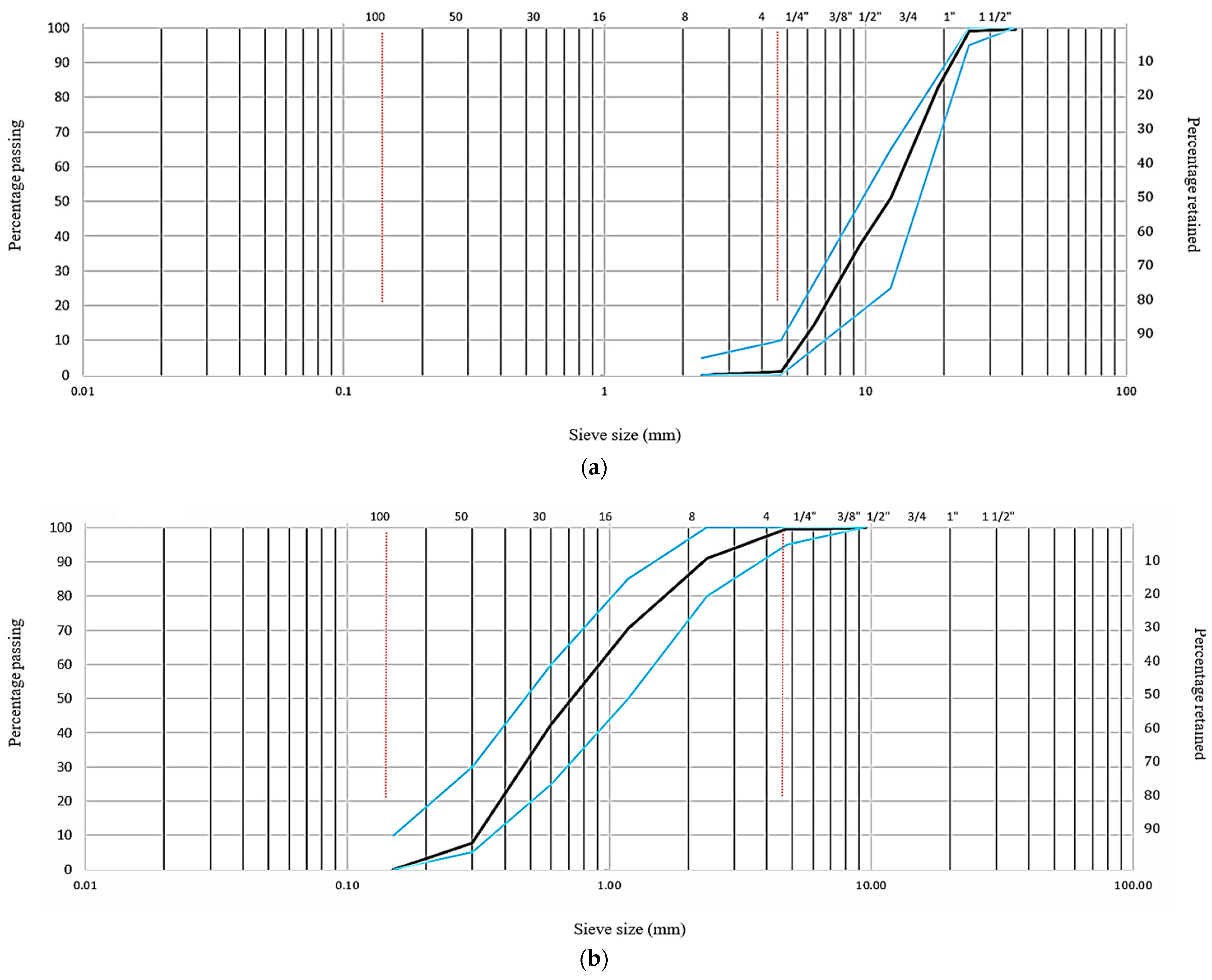

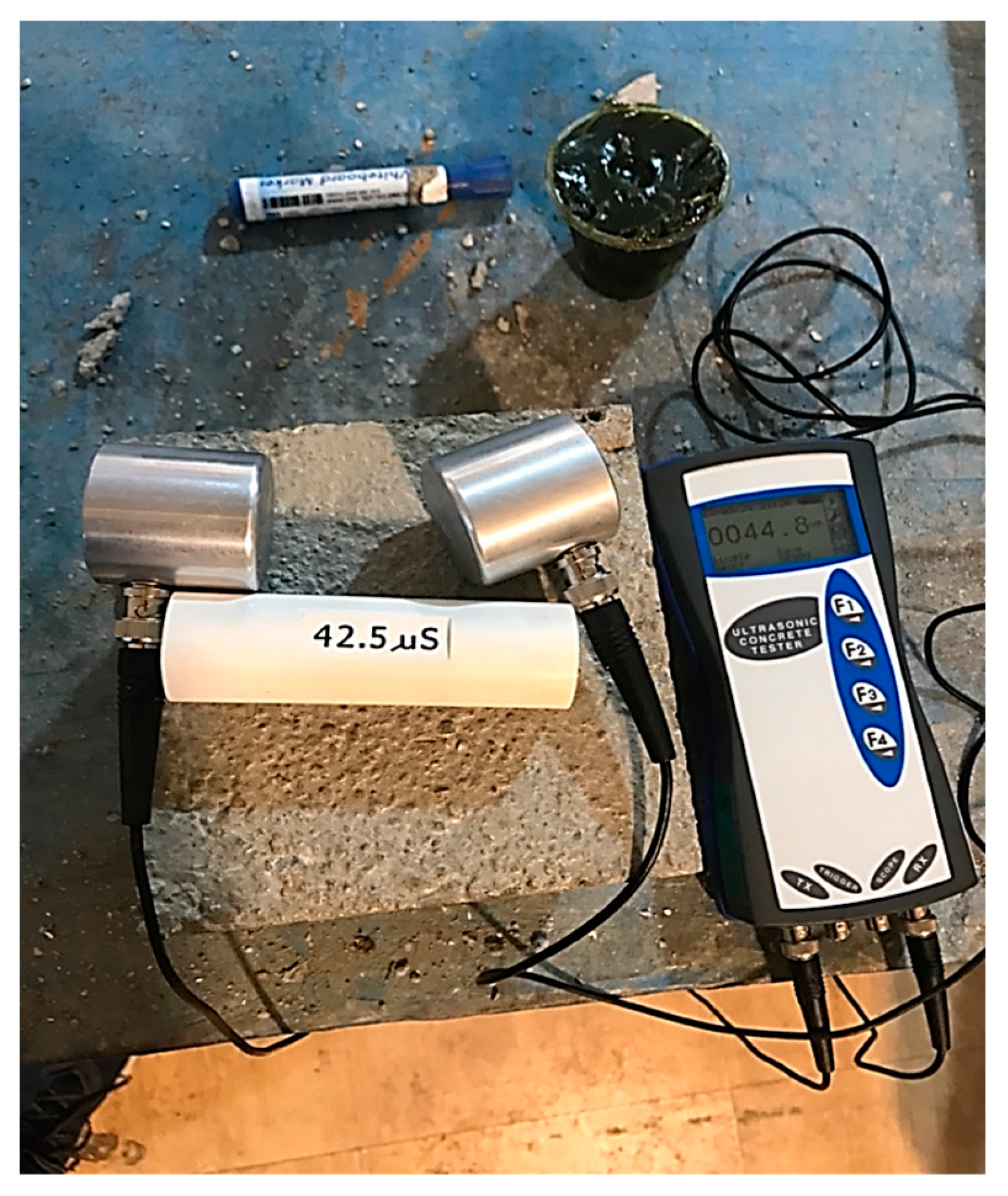

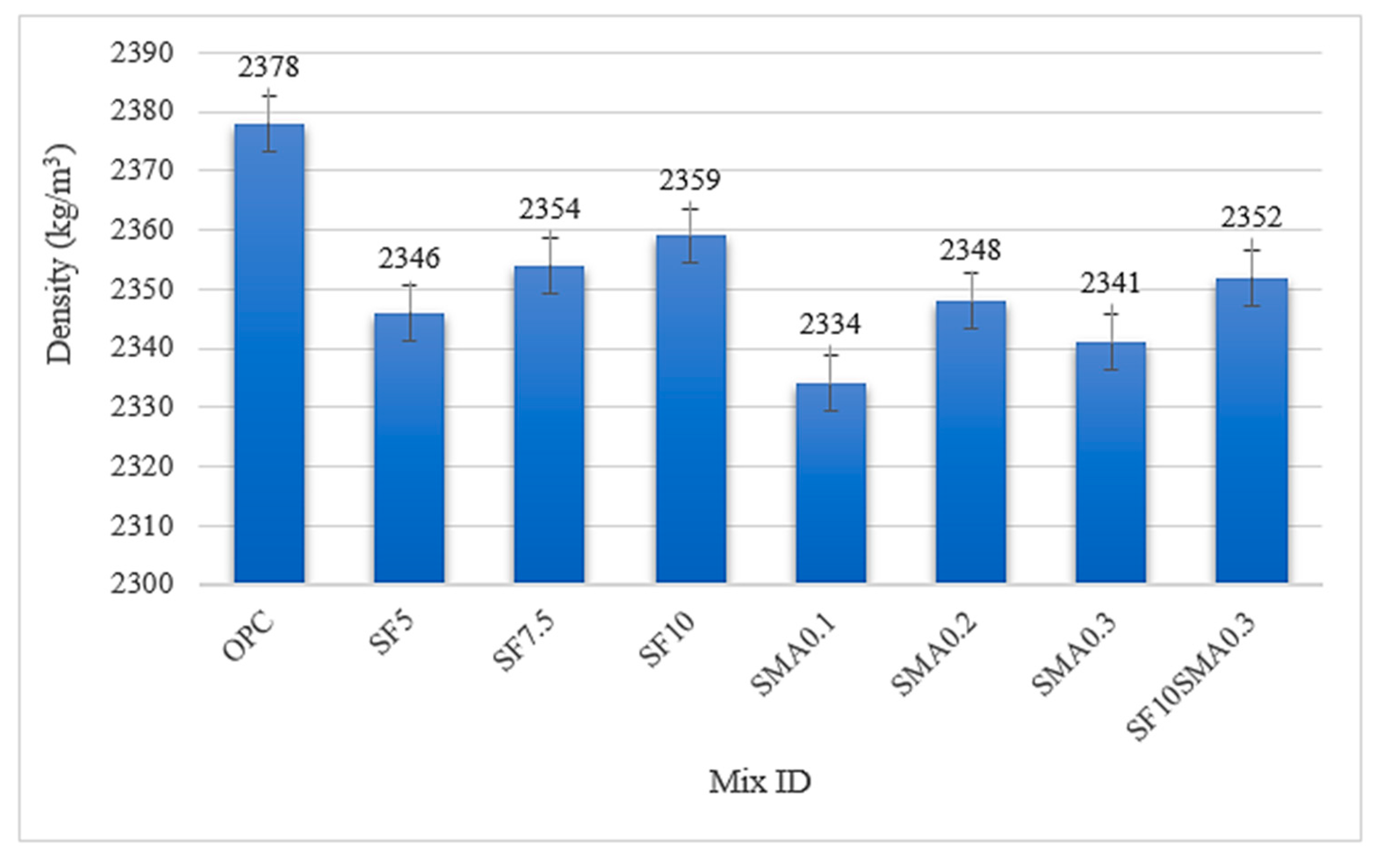
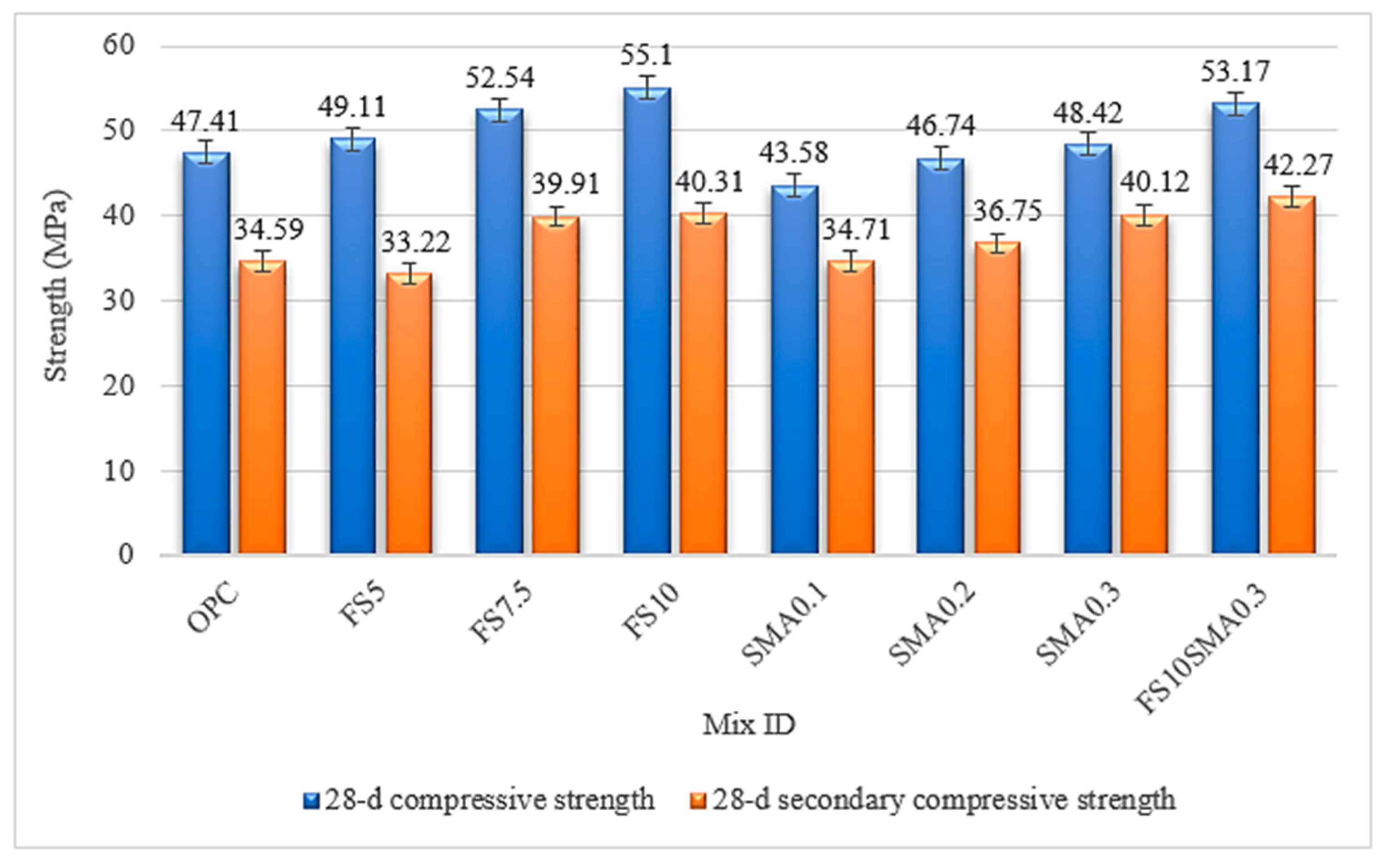
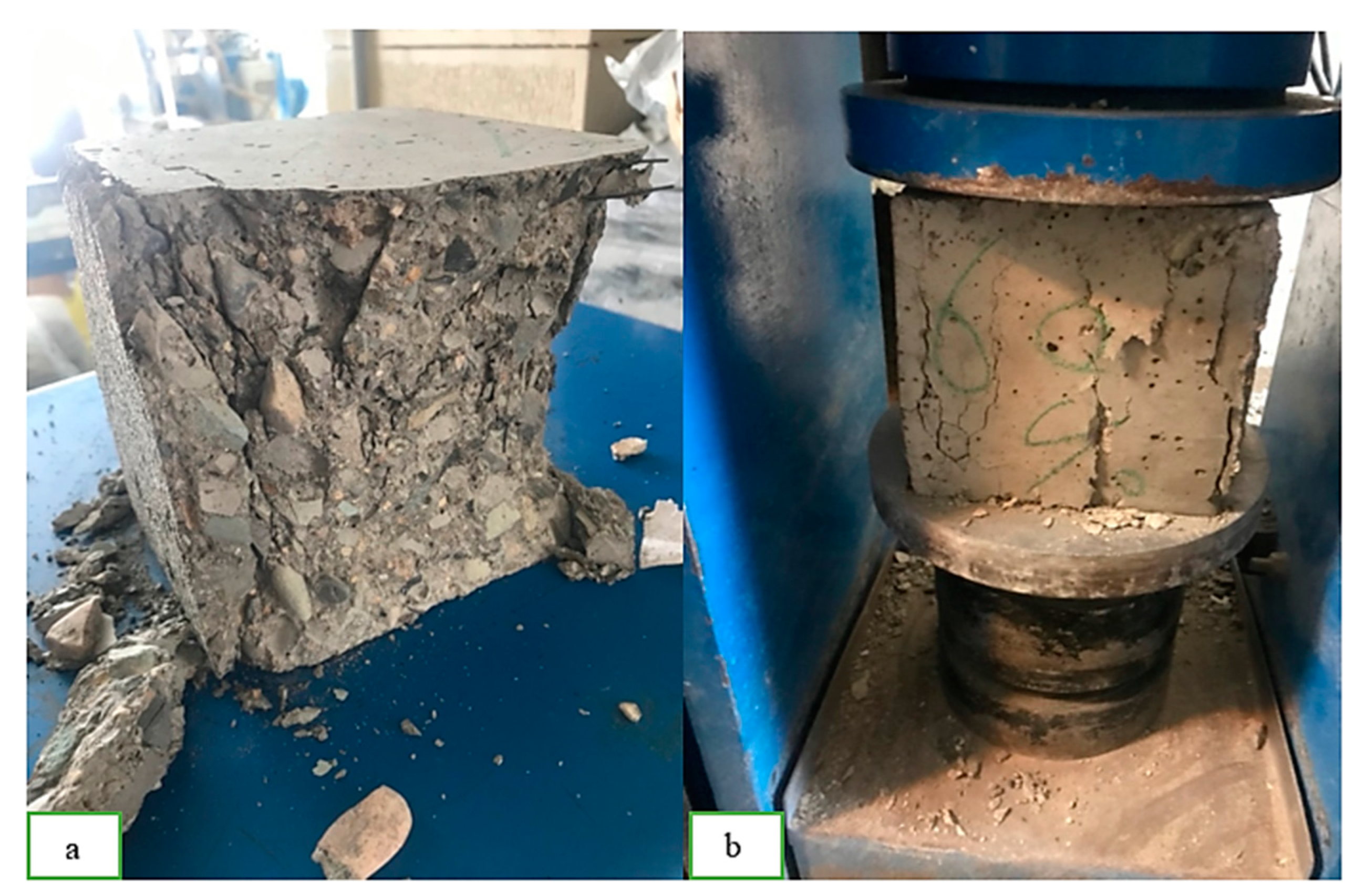


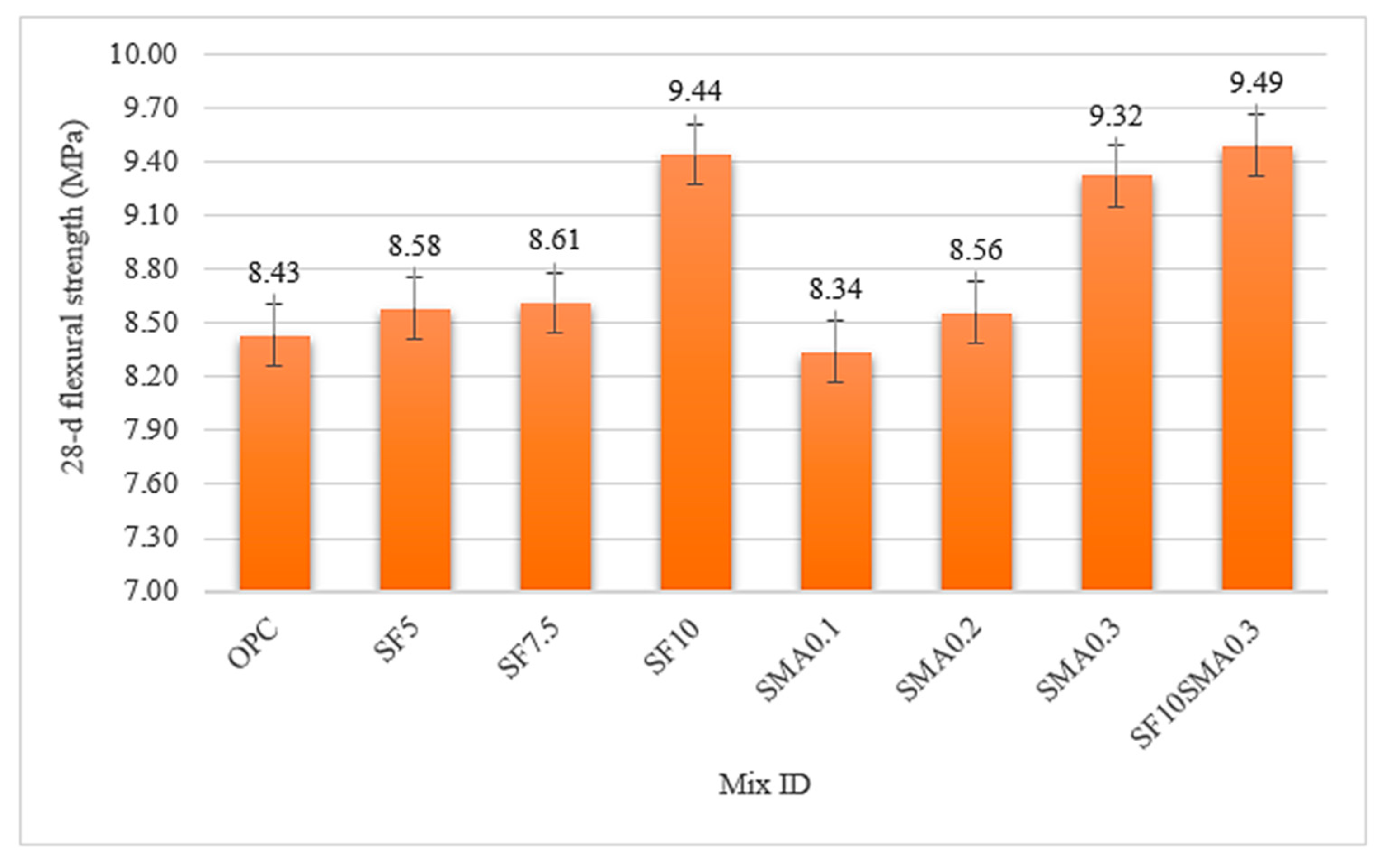


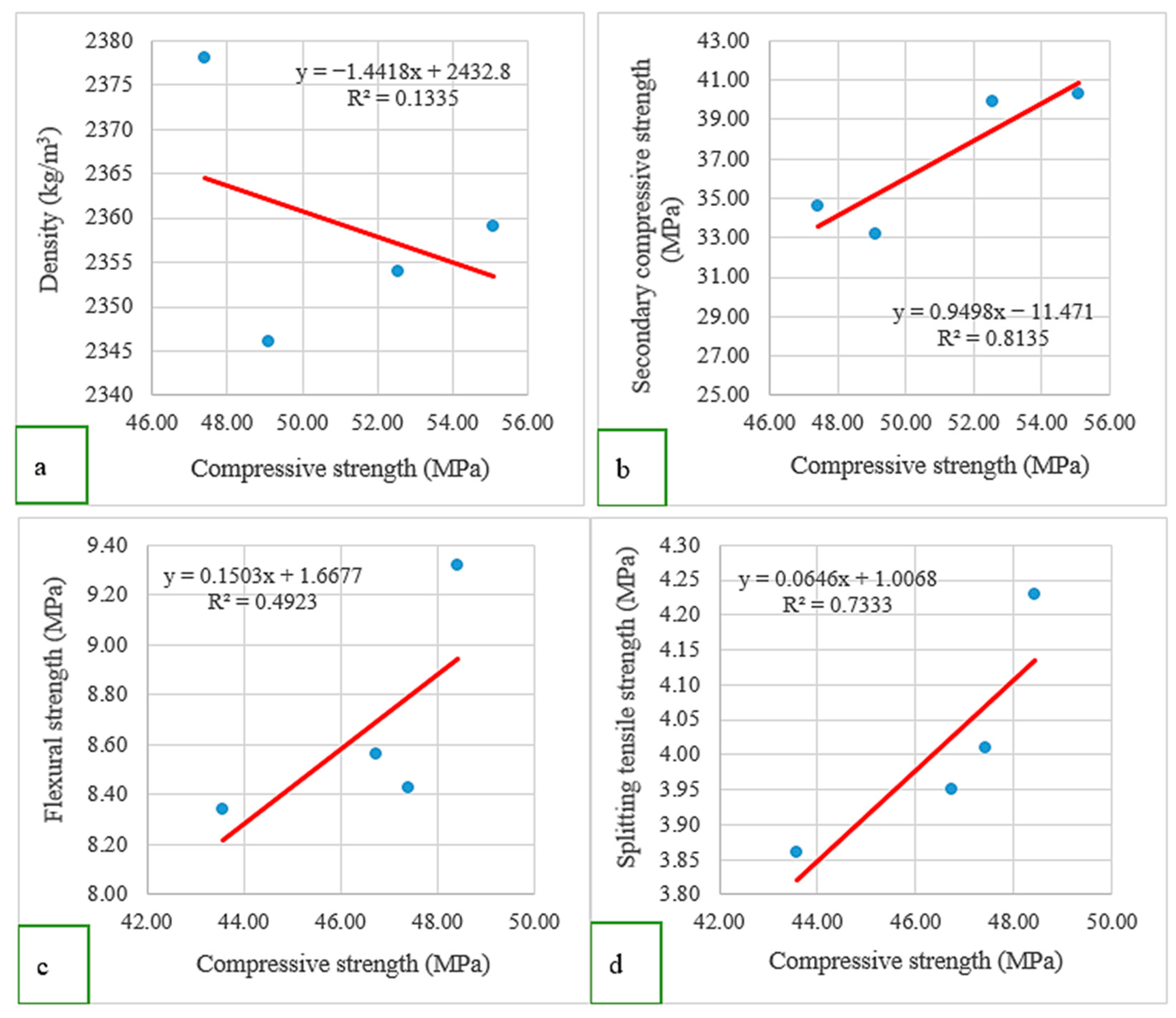
| Compounds | SF | SMA | Cement |
|---|---|---|---|
| SiO2 | 94.38 | - | - |
| Fe2O3 | 1.22 | - | 4.19 |
| Al2O3 | 2.75 | - | 4.95 |
| CaO | - | - | 62.28 |
| SO3 | - | - | 2.2 |
| MgO | 0.54 | - | 3.2 |
| Na2O | - | - | 0.6 |
| K2O | - | - | 0.45 |
| P2O5 | - | - | 1.18 |
| Ti | - | 44.25 | - |
| Ni | - | 55.71 | - |
| C | - | 0.004 | - |
| O | - | 0.04 | - |
| L.O.I | 1.11 | 0.0001 | 0.0001 |
| Characteristics | Unit | Results |
|---|---|---|
| Wire diameter | mm | 1 |
| Wire length | mm | 50 |
| Young’s modulus martensite | GPa | 28–40 |
| Young’s modulus austenite | GPa | 70–98 |
| Yield strength martensite | MPa | 70–140 |
| Yield strength austenite | MPa | 195–690 |
| Ability to change the length | % | 10.15 |
| Shape | - | Straight |
| Color | - | Dark |
| Mix ID | Cement (kg) | Sand (kg) | Gravel (kg) | SF (kg) | SMA (kg) | W/C |
|---|---|---|---|---|---|---|
| OPC | 400 | 1100 | 740 | - | - | 0.4 |
| SF5 | 380 | 1100 | 740 | 20 | - | 0.4 |
| SF7.5 | 370 | 1100 | 740 | 30 | - | 0.4 |
| SF10 | 360 | 1100 | 740 | 40 | - | 0.4 |
| SMA0.1 | 400 | 1100 | 740 | - | 6.5 | 0.4 |
| SMA0.2 | 400 | 1100 | 740 | - | 13 | 0.4 |
| SMA0.3 | 400 | 1100 | 740 | - | 19.5 | 0.4 |
| SF10SMA0.3 | 360 | 1100 | 740 | 40 | 19.5 | 0.4 |
Disclaimer/Publisher’s Note: The statements, opinions and data contained in all publications are solely those of the individual author(s) and contributor(s) and not of MDPI and/or the editor(s). MDPI and/or the editor(s) disclaim responsibility for any injury to people or property resulting from any ideas, methods, instructions or products referred to in the content. |
© 2024 by the authors. Licensee MDPI, Basel, Switzerland. This article is an open access article distributed under the terms and conditions of the Creative Commons Attribution (CC BY) license (https://creativecommons.org/licenses/by/4.0/).
Share and Cite
Xie, Y.; Far, H.; Mortazavi, M.; El-Sherbeeny, A.M. Improving the Mechanical Properties of Concrete Mixtures by Shape Memory Alloy Fibers and Silica Fume. Buildings 2024, 14, 1709. https://doi.org/10.3390/buildings14061709
Xie Y, Far H, Mortazavi M, El-Sherbeeny AM. Improving the Mechanical Properties of Concrete Mixtures by Shape Memory Alloy Fibers and Silica Fume. Buildings. 2024; 14(6):1709. https://doi.org/10.3390/buildings14061709
Chicago/Turabian StyleXie, Yuanyong, Harry Far, Mina Mortazavi, and Ahmed M. El-Sherbeeny. 2024. "Improving the Mechanical Properties of Concrete Mixtures by Shape Memory Alloy Fibers and Silica Fume" Buildings 14, no. 6: 1709. https://doi.org/10.3390/buildings14061709
APA StyleXie, Y., Far, H., Mortazavi, M., & El-Sherbeeny, A. M. (2024). Improving the Mechanical Properties of Concrete Mixtures by Shape Memory Alloy Fibers and Silica Fume. Buildings, 14(6), 1709. https://doi.org/10.3390/buildings14061709








